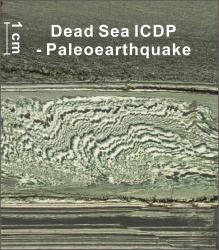A recent study investigated turbidites that preserved in a 457-m deep ICDP drilling from the Dead Sea depocenter. This is the first work to show detailed information on turbidites in the region.
1. Key Points:
- Seismic origin for prehistoric turbidites is established by analyzing the underlying in situ deformation structures for each turbidite
- Data validate a previous hypothesis that soft-sediment deformation formed at the sediment-water interface in the Dead Sea
- The new approach permits a more confident geohazard assessment by improving the completeness of a paleoseismic archive

2. Overview
Seismogenic turbidites are widely used for geohazard assessment. The use of turbidites as an earthquake indicator requires a clear demonstration that an earthquake, rather than non-seismic factors, is the most plausible trigger. The seismic origin is normally verified either by correlating the turbidites to historic earthquakes, or by demonstrating their synchronous deposition in widely spaced, isolated depocenters. The correlated historic earthquakes could thus constrain the seismic intensities necessary for triggering turbidites. However, the historic correlation method is not applicable to prehistoric turbidites. In addition, the synchronous deposition of turbidites cannot be verified if only one deep core is drilled in a depocenter.
Here, we propose a new approach that involves analyzing the underlying in situ deformations of prehistoric turbidites, as recorded in a 457 m-long core from the Dead Sea center, to establish their seismic origin. In addition, our high-resolution chemical and sedimentological data validate a previous hypothesis that soft-sediment deformation in the Dead Sea formed at the sediment-water interface (Marco and Agnon, 1995, Geology). Moreover, we use our results to propose seven basic earthquake-related depositional scenarios preserved in depocenters located in tectonically active regions like the Dead Sea. These techniques and findings permit a more confident geohazard assessment in the region and other similar tectonic settings by improving the completeness of a paleoseismic archive.

Fig. 1. Tectonic setting of the Dead Sea Basin (a) and chemical data characterizing in situ seismites (d-m) (Lu et al., 2020b) and background deposits (b-c, n-o) in Core 5017-1. (a) Active faults in the basin (Bartov et al., 2006; Ben-Avraham et al., 2008). (b) Gypsum. (c) Halite. (d-m) in situ seismites: (d-e) Linear waves (Lw); (f-g) Asymmetric billows (Ab); (h-i) Coherent vortices (Cv); (j-k) Micro-faults (Mf); (l-m) Intraclast breccias (Ib). (n-o) Background deposits; aad, alternating laminae of aragonite and detritus; cps, count per second.

Fig. 2. XRF data characterizing Type I turbidites from the Dead Sea center. (a-l) Turbidites (brown color) overlie in situ soft-sediment deformations (pink color). (m-r) Turbidites overlying micro-faults. See Text S5 for core depth.

Fig. 3. Scatter plots of Ca and Ti for different types of sediments. (a) Relatively similar clusters of aad and deformed aad (i.e., Lw, Ab, and Cv); (b) Type I turbidites, Type II turbidites, and homogeneous mud (generated by flash floods) from the Dead Sea center (Core 5017-1) group in distinct clusters. The aad and homogeneous mud are background deposits; n, number of data points.
![]()

Fig. 4. XRF data characterizing Type II turbidites (the laminae fragments-embedded detritus layers) from the lake center (Core 5017-1). (a-c) The layers from the lake margin (Ein Gedi core) that correlate with historic earthquakes (Migowski et al., 2004; Agnon et al., 2006) are used for comparison. (d-k) The layers from the lake center (brown color) are overlying in situ seismites. (l-p) The layers from the lake center without underlying in situ seismites. The red arrows indicate the remaining parts of Cv; the magenta circles are magnifying glasses (x2.5). See Text S6 for core depth.

Fig. 5. Seismogenic sedimentary processes and deposition models in the Dead Sea. (a) Random relationship between the thickness of prehistoric turbidites and seismic intensity. (b) Schematic model showing co-seismic sedimentary processes in the lake. (c) Earthquake-related deposition models in the lake depocenter. See the text for a detailed interpretation.

Fig. S2. High-resolution core images showing the contact between turbidites and in situ seismites, with erosive base of seismogenic slumps and chaotic deposits from the Dead Sea center (Core 5017-1).
3. More details can be found at:
(Open Access) Doi:10.1029/2020gl090947: https://www.researchgate.net/profile/Yin_Lu22



No Comments
No comments yet.